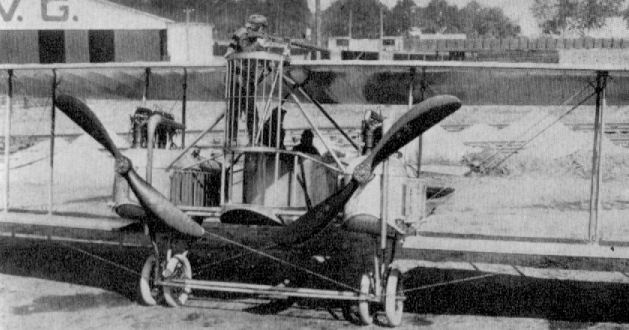
Описание
Страна: Германия
Год: 1915
O.Thetford, P.Gray German Aircraft of the First World War (Putnam)
L.V.G. G I
Although designated in the G series, this 1915 aircraft was more in the nature of a "Battleplane" (in common with the A.E.G. G I) than a bombing aircraft. As far as is known only a single machine was built. Engines, two 150 h.p. Benz Bz III driving handed airscrews.
Описание:
- O.Thetford, P.Gray German Aircraft of the First World War (Putnam)
- J.Herris LVG Aircraft of WWI. Vol.3: Types C.VI-C.XI & Fighters (A Centennial Perspective on Great War Airplanes 36)
- M.Dusing German Aviation Industry in WWI. Volume 1 (A Centennial Perspective on Great War Airplanes 84)
Фотографии
-
M.Dusing - German Aviation Industry in WWI. Volume 1 /Centennial Perspective/ (84)
The LVG G.I was designed as a Kampfflugzeug, and a single example was built in 1915. The arrangement enabled the gunner to fire in a 360° arc above the aircraft and gave a wide field of fire forward, but the standing gunner undoubtedly created a great deal of drag, limiting the aircraft's speed. The Kampfflugzeugs (battle planes) of all types soon proved failures as interceptors and air superiority aircraft because they were simply too slow and cumbersome to intercept and engage enemy aircraft. Operational experience soon demonstrated that bombing was the true role of these aircraft, and the early operational Kampfflugzeugs were the ancestors of German twin-engine bombers of WWI.
-
J.Herris - LVG Aircraft of WWI. Volume 3: Types C.VI-C.XI & Fighters /Centennial Perspective/ (36)
The LVG G.I had a large wingspan in addition to the significant drag of its gunner, who stood upright to use his weapon. The excessive drag ensured the LVG G.I could not be fast enough to successfully intercept enemy aircraft, the fatal flaw with the battle plane concept as a weapon. (Peter M. Grosz Collection/SDTB)
-
J.Herris - LVG Aircraft of WWI. Volume 3: Types C.VI-C.XI & Fighters /Centennial Perspective/ (36)
The LVG G.I in front of the LVG factory with the gunner still exploring the field of fire of his flexible machine gun. Many national insignia decorated the LVG G.I to identify it to friendly aircraft and avoid a 'friendly fire' accident. (Peter M. Grosz Collection/SDTB)
-
J.Herris - LVG Aircraft of WWI. Volume 3: Types C.VI-C.XI & Fighters /Centennial Perspective/ (36)
Two more views of the LVG G.I showing additional details and the enthusiastic gunner still exploring the wide field of fire available to him. The raised gun mount gave a 360° field of fire above the upper wing. (Peter M. Grosz Collection/SDTB)





